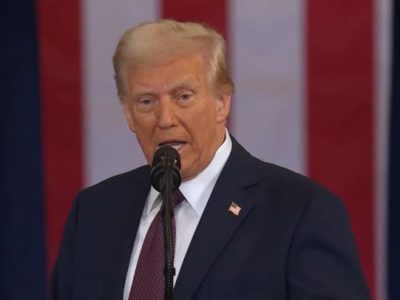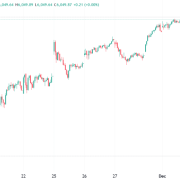
True to the month’s reputation, September has brought in much volatility for markets in India and the world over and caution has set in among investors.
Beyond the September 17-18 meeting of the Federal Reserve wherein the central bank is poised to slash rates, focus on the outcome of the US presidential elections will be dialled up, which is likely to keep the volatility going.
In India, after hitting the milestone of 25,000, the benchmark Nifty is back to flirting with it, reflecting the volatility.
However, it is the frenzy around the SME IPO that has become a big theme in the Indian stock markets. In the last eight months, about 165 SME companies have raised a whopping Rs 5,894 crore, against 99 companies raising Rs 2,589 crore in the same period last year.
Another dominant theme is the overvaluation of stocks in the mid-cap and small-cap categories.
Invezz spoke to Sneha Poddar, vice president of research, and wealth management at the prominent Indian brokerage Motilal Oswal Financial Services to understand more about the current state of the market, how to navigate the volatility, and how to spot reasonable picks amid the overvaluation. Edited excerpts:
Invezz: It is all but certain that the Fed will cut rates later this month. How will markets in India be impacted?
People are already building in the rate cuts. Earlier, the hopes were for a 50 bps rate cut, but now somehow the kind of data that has come out from the US, chances are that the Fed might go ahead with a 25 bps rate cut.
If 50 bps comes in, then the event has played out and so there will be profit booking, and if 25 bps comes in, there will be a disappointment and there would be some sort of volatility and correction.
September and October to be volatile
In any scenario what we feel is probably the month of September will be highly volatile. We are already witnessing profit booking and that is most likely to continue this month. It would be largely trading in a broad range, witnessing a lot of ups and downs.
This should continue even into October because the US elections will take place at the beginning of November.
Once this event (rate cut) plays out, October will witness a focus on the US election. So, the volatility will again be induced in the markets.
Therefore, both September and October are expected to be highly volatile. It is already starting to play out.
Once these two major events- the US Fed meeting and the US elections- are over, the market would have seen decent correction by that time and post that we might see recovery.
Therefore, from November onwards things should start improving for the overall market.
Invezz: What is your word of caution for investors during such volatile times in terms of what sectors to stick to? Also, what kind of opportunities does this phase open up?
There are two types of investors- traders and long-term investors. For traders, my suggestion will be to stay a little light and trade cautiously. Don’t go overboard or make very aggressive calls.
Opportunity in volatility
But, for long-term investors, this presents a good opportunity. On days of sharp corrections, one should seek the opportunity and invest from a long-term perspective.
This is because overall from India’s perspective, we don’t see any risk per se in the market. The volatility which is being induced is because of the global factors.
On the Indian front, yes there are a few major state elections which are coming up, but still, they will not have a major impact.
So, from the next five-year perspective, the India story remains intact. The corporates can deliver decent earnings. And, of late, we have seen GDP growth upgrades from global agencies.
Therefore, with the India story intact, these corrections present a good opportunity to enter the market or to enter the sectors or stocks which will perform well from the next four to five years perspective.
Now, talking about what kind of sectors should one look at under this scenario, since the markets will be highly volatile, it’s important to stick to haven kinds of sectors.
Avoid commodity-related stocks for now, go for FMCG, IT, pharma
One should refrain from going for very volatile sectors or for the ones which are linked to the commodity prices as there would be lots of ups and downs.
FMCG, IT, and pharma are some of the safer sectors. You can also add insurance to that list.
Insurance has not performed so far but over the last month or so, they’ve started participating as the numbers have started coming in pretty decent from all the companies, and the outlook which they’re giving has turned quite positive.
In IT, what we’re witnessing is that at least a green shoot is visible in terms of a turnaround and probably as we move ahead things will get stronger.
IT is one space which has seen a run up but then we feel like the recovery has just started and there’s a long road to the runway.
In FMCG, over the last two quarters, the volume uptick has started and now with the monsoon being quite decent this time, rural recovery should start kicking in which should further support your volume update.
Therefore, both on these staple and discretionary sides things are looking good, plus the festive season is there.
It has already started with Ganesh Chaturthi. Next, there will be Onam, then Navratri, then Diwali, and then the wedding season will start.
Therefore, generally, the second half should be good for the FMCG companies and the commentaries have also turned quite positive from the FMCG players, especially in Q1.
In pharma, the numbers were quite decent in Q1 and the outlook which has come in looks quite positive. Therefore, these are the sectors we are positive about.
Invezz: Indian markets are quite overvalued currently. Valuations of which sectors justify their fundamentals, and which sectors are seeing a high mismatch between fundamentals and valuation?
Talking about valuations, the large caps are not overly priced. They are fairly priced because if we look at one year forward earnings for large-cap, it is currently around 20.5-21 times.
And if you look at the long-term average, it also hovers around a similar level of 20-20.5.
It’s the mid-cap and the small cap which is quite aggressively priced in. In that case, one should be cautious and take more of a stock-specific approach.
I’m not saying that there are no pockets wherein you can find opportunity. But, if you are building your portfolio, then large caps should occupy 60%- 70% because there’s still a room for price appreciation, whereas mid caps and small caps are largely overvalued.
It is because they are concept stocks or they are witnessing sharper growth therefore somehow they’re justifying the higher valuation.
But because the markets will be volatile over the next few months you should move more towards large caps rather than mid and small caps.
One should go for mid and small caps for alpha generation and a lot a smaller portion to them in your portfolio.
Finding fairly priced stocks in an overvalued Indian market
Talking about sector-wise valuation, there are just a few sectors wherein the valuation comfort is there, but then somehow the triggers are missing.
For example, auto has corrected a little and now, it’s trading at a discount to its long-term average.
But in the case of auto, what we’re witnessing is some sort of moderation in growth. The sector has already witnessed a sharp run-up over the last few years. Now, the base impact is also there.
Plus at the same time, the overall growth has slowed down a little. So if we talk about any particular pocket then within auto probably the four-wheelers and four-wheelers SUV segment is still doing decent otherwise in other pockets there’s a slowdown.
Now, the two-wheelers segment is expected to perform decently if you’re buying during the festivals and the wedding season.
Therefore, we can look at auto selectively, but otherwise, one should not go too overboard on it because the growth has slowed down a little.
Coming to banking, obviously with the rate cut expected, the banking sector will not perform well. Also, we have seen a decent correction in banking especially in the PSU banks.
So even though they are trading at a discount, we are not suggesting banking to clients now, but long-term investors can accumulate it during the stock correction.
But we are not suggesting banking to medium-term investors or investors with a short-term horizon.
NBFCs, insurance, oil & gas fairly priced
NBFC has not participated so far in the rally and the valuation comfort is there. They will also obviously benefit from the rate cut as well because their cost of borrowing will get lowered, which will drive growth for them.
So, we are turning positive on NBFC.
Insurance, I mentioned that we’re quite positive on and that is one sector which is fairly valued.
In retail also the valuation comfort will be there, but the sector is not doing well per se. The footfalls haven’t improved at the stores so that concern continues.
It has to be seen, whether during active times it picks up or not but the management commentary so far is also not providing comfort.
Trent is one outlier which is why the valuation is also expensive for them. But apart from Trent, none of the other players are participating per se from the retail sector.
Oil and gas is marginally overpriced but not too expensive. Within oil and gas, OMCs are currently one segment where one can focus because oil prices are at a 18-months low.
So, that provides a lot of comfort in terms of improvement in marketing margins. Therefore, we are pushing OMCs to the clients.
What is fuelling the SME IPO demand in India?
Invezz: India has also been an outlier in terms of IPO demand at a time when the IPO market is down the world over. SME IPOs are especially seeing a lot of frenzy…
IPO market follows the secondary market which is booming in India. The market is at an all-time high and they have seen a sharp run-up over the last year, especially the mid-caps and the small caps.
So obviously when the markets do well the unlisted companies want to take benefit out of it.
Therefore, a majority of the IPOs that we see are from the midcap and the small caps space because everyone wants to benefit from the high valuation.
Otherwise, when the markets are dim, they cannot seek very high valuations. It’s only during a vibrant market that you can demand any sort of premium and people would be ready to pay for it.
Post listing probably whatever be the case but at least from a listing perspective, you get a very healthy listing.
Some companies even see listing at a 100% premium. All this happens because the markets are doing well, and when the markets are very bullish, then in those scenario, obviously, the valuations don’t hold that much importance. Investors don’t think very rationally.
That’s the main reason why the Indian IPO market is doing well because of the strong bull run that we witnessed over the last year.
Historically also, if the profit booking which has started, continues for a few months, again, the IPO market will go down and people will start delaying their IPO.
Can India see more all-time highs before fiscal end?
Invezz: Is there still some room for more all-time highs in the Indian market before the fiscal ends?
That’s a difficult thing to predict. It all depends upon how the earnings delivery happens in the second half.
US Fed will cut the rates but then the market focus will shift to if and when the RBI will cut the rate.
People are not expecting the RBI to cut the rate this year. They are expecting that it will start cutting rates probably beginning of next year.
So, that will also play a very important role. Also, we have already crossed 25,000 mark, therefore the market is slightly on a higher valuation side.
For the markets to reach 26,000 or 27,000, that kind of visibility is not there currently.
Probably, by the end of this fiscal, we might again near the previous highs that got created recently.
Fed rate cut, MSCI weightage likely to attract FPI inflows
Invezz: Will the Fed rate cut lead to higher FPI inflows?
One thing is visible the FII selling has moderated now. There are days of ups and downs where some days they sell more and some days they buy more but at least the selling part has moderated.
With the rate cut, obviously there will be some sort of a push for FPI flows to come into the Indian market but with what intensity it comes in that has to be really seen.
I don’t see it coming with greater intensity over the next two months at least because till the clarity doesn’t emerge on the US front with regards to the election, I think people will be more in a wait-and-watch kind of mode.
Post that, probably, the flows should start kicking in.
Also, in MSCI, India’s weightage has increased so this can also lead to increased FPI flows into the Indian market.
Message to long-term investors
I feel like from November we should see a good recovery in the market. My message to the long-term investors is to make the most of these next two months.
A lot of volatility will be seen so one can take benefit of this and build a good quality portfolio which should be well diversified across mid-caps and large-caps because if mid-caps and small-caps do witness a sharp correction then that will actually present them a very good entry point, especially to the retail investors who are more keen to invest in smaller companies rather than larger companies.
Also, with the rate cut coming in, the mid-caps and the small-cap companies will benefit more compared to the large caps.
It will be a boon for them. So, one can do their homework and with good stock selection, one can build a good portfolio.
The post Interview: September & October good for going long, Poddar of Motilal Oswal suggests investors appeared first on Invezz









